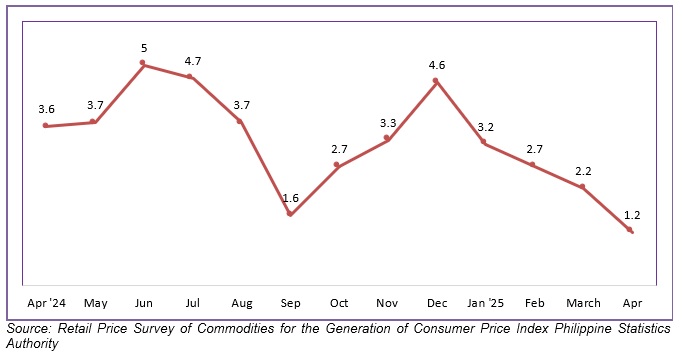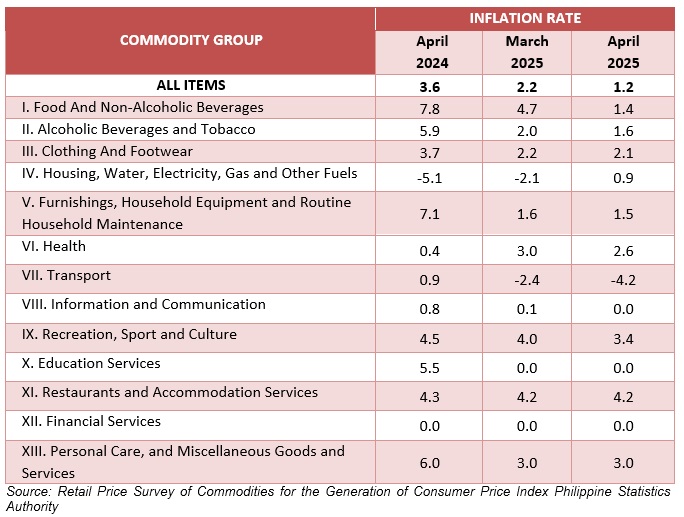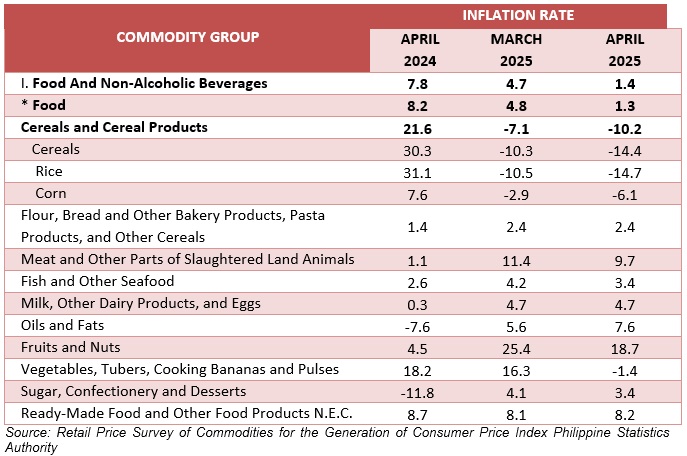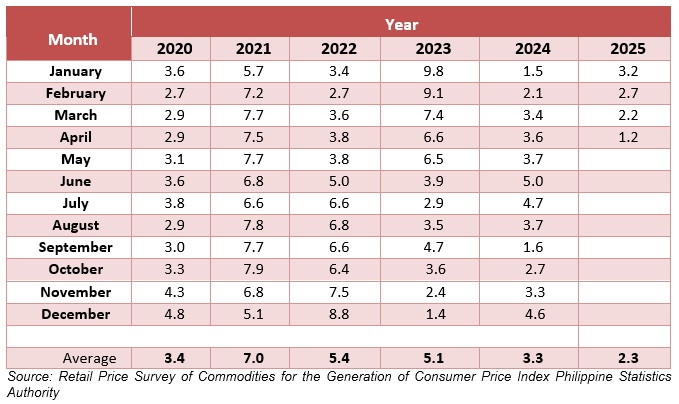Figure 1. Inflation Rates, Nueva Vizcaya, All Items
(2018=100)

The year-on-year headline inflation rate in Nueva Vizcaya decelerated to 1.2 percent in April 2025 from 2.2 percent in March 2025. Also it decreases by 2.4 percent from 3.6 percent inflation rate in April 2024.
The average inflation rate of Nueva Vizcaya for the calendar year 2025 (January–April) stood at 2.3 percent.
Table 1. Year-on-year Changes of the Consumer Price Index in Percent
in Nueva Vizcaya by Commodity Group
April 2024, March 2025 and April 2025
(2018=100)

The main drivers in the downward trend inflation for all income households in April 2025 were as follows; (Table 1)
Food and non-alcoholic beverages,1.4 percent from 4.7 percent;
Transport, -4.2 percent from -2.4 percent; and
- Health, 2.6 percent from 3.0 percent.
Additionally, five (5) commodity groups also showed a downward trend inflation rate for the month of April 2025, were as follows:
Alcoholic Beverages and Tobacco, 1.6 percent from 2.0 percent;
Clothing and Footwear, 2.1 percent from 2.2 percent;
Furnishings, Household Equipment and Routine Household Maintenance, 1.5 percent from 1.6 percent;
Information and Communication, 0.0 percent from 0.1 percent; and
Recreation, Sport and Culture, 3.4 percent from 4.0 percent.
On the contrary, the following one (1) commodity group recorded increasing trend inflation rates in the year-on-year increase of index:
Housing, Water, Electricity, Gas and Other Fuels, 0.9 percent from -2.1 percent.
Meanwhile, the last four (4) commodity groups either retained their inflation rates from the previous month or had a zero percent annual rates:
Education Services, 0.0 percent from 0.0 percent;
Restaurants and Accommodation Services, 4.2 percent from 4.2 percent;
Financial Services, 0.0 percent from 0.0 percent; and
d. Personal Care, and Miscellaneous Goods and Services, 0.0 percent from 0.0 percent.
Table 2. Consumer Price Index for All Income Households in Nueva Vizcaya
April 2024, March 2025 and April 2025
(2018=100)

In food index, the province's inflation rate in April 2025 was decreased by 3.5 percent from 4.8 percent in the previous month and 6.9 percent from 8.2 percent in April 2024. (Table 2)
Main Drivers to the Downward Trend inflation rate on Food Index were the following:
Meat and other parts of slaughtered land animals, 9.7 percent from 11.4 percent;
Fish and Other Seafood, 3.4 percent from 4.2 percent;
Fruits and Nuts, 18.7 percent from 25.4 percent; and
Sugar, confectionery and desserts, 3.4 percent from 4.1 percent.
In contrary, two (2) food groups had an upward trend inflation rates:
Oils and Fats, 7.6 percent from 5.6 percent; and
b. Ready-made food and other food products, 8.2 percent from 8.1 percent.
Meanwhile, three (3) food groups showed negative inflation rate:
Rice, -14.7 percent from -10.5 percent;
Corn, -6.1 percent from 2.9 percent; and
Vegetables, Tubers, Cooking Bananas and Pulses, -1.4 percent from 16.3 percent.
The following two (2) food groups retained their previous month’s inflation rate:
Flour, Bread, and Other Bakery Products, Pasta Products, and Other Cereals, 2.4 percent from 2.4 percent; and
b. Milk, other dairy products and eggs, 4.7 percent from 4.7 percent.
Table 3. Year-on-year Rates in Nueva Vizcaya
All Items in Percent
January 2020 – April 2025
(2018 = 100)

DEFINITIONS AND CONCEPTS
Price
Is the amount or value paid in exchange for the commodity or a service rendered.
Retail Consumer Price
refers to the price at which a commodity is sold in small quantities for consumption.
Market Basket
a term used to refer to a sample of goods and services that are commonly purchased and bought by an average Filipino household.
Consumer Price lndex (CPl)
it is an indicator of the change in the average retail prices of a fixed basket of goods and services commonly purchased by an average Filipino household. lt shows how much on the average, prices of goods and services have increased or decreased from a particular reference period known as base year.
lnflation Rate
is an indicator derived from the CPl. lt refers to the annual rate of change or the year-on-year change of the CPI expressed in percent. lnflation is interpreted in terms of declining purchasing power of money.
Weight
a value attached to a commodity or group of commodities depending on the magnitude of its contribution to the index.
Base Period
a reference date at which the index is equal to 100. Base year is 2018.
lndex Methodology
a Laspeyre's formula: fixed base year and weights.
Purchasing Power of the Peso (PPP)
the measure of how much the peso in the base period is worth in the current period.
Percentage Change
is a simple mathematical concept that represents the degree of change over time. lt is used for many purposes in finance, often to represent the price change of a security.
Headline lnflation
measures changes in the cost of living based on movements in the prices of a specified basket of major commodities. lt refers to the annual rate of change or the year-on-year change in the Consumer Price lndex (CPl).
CHOLLY L. BAYON
Chief Statistical Specialist
